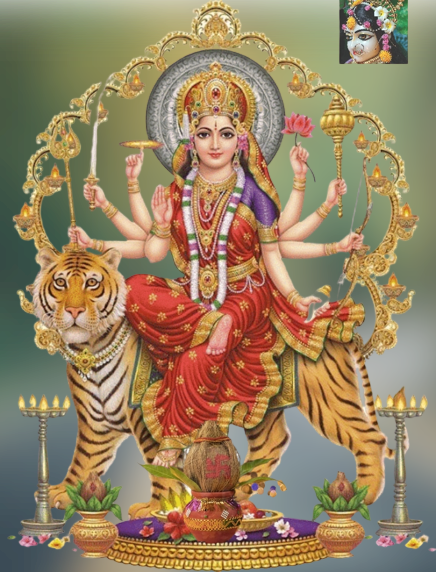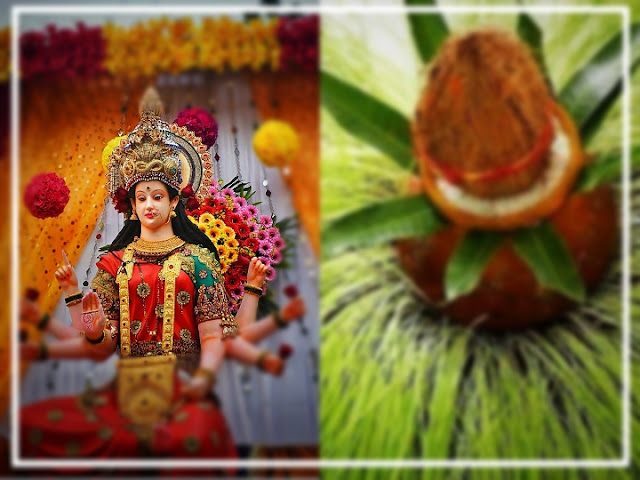Chaitra Navratri: Celebrating the Victory of Good over Evil
Chaitra Navratri is a nine-day festival celebrated in the Hindu calendar month of Chaitra, which falls in March or April every year. This festival is dedicated to the worship of the nine forms of Goddess Durga, who symbolizes feminine power and strength. It is believed that during this time, the Goddess descends to earth to bless her devotees and remove their troubles.
The word 'Navratri' is derived from two Sanskrit words, 'nava' meaning nine and 'ratri' meaning night. Each day of the festival is dedicated to one form of Goddess Durga, and on the tenth day, which is also known as Vijayadashami or Dussehra, her victory over the demon Mahishasura is celebrated.
Chaitra Navratri is celebrated with great fervor and enthusiasm across India. People fast and offer prayers to the Goddess during these nine days. The rituals and customs may vary from region to region, but the underlying theme of the festival remains the same - the triumph of good over evil.
Here are some of the customs and traditions associated with Chaitra Navratri:
1. Ghatasthapana - On the first day of Navratri, a pot or kalash filled with water is placed in the puja room or mandap, and a coconut is placed on top of it. This represents the presence of Goddess Durga in the house.
2. Fasting - Many people observe a fast during Navratri, either by consuming only fruits and milk or by abstaining from food and water altogether. It is believed that fasting purifies the body and mind, and helps one focus on the spiritual aspect of the festival.
3. Puja and Aarti - Devotees perform puja and aarti every day of Navratri, offering flowers, fruits, and other offerings to the Goddess. The aarti is performed with a diya or lamp, and devotional songs are sung in praise of the Goddess.
4. Kanya Pujan - On the eighth day of Navratri, nine young girls are invited to the house and offered food and gifts. This is known as Kanya Pujan, and it is believed to be a way of honoring the divine feminine.
5. Vijayadashami - On the tenth day of Navratri, the victory of Goddess Durga over Mahishasura is celebrated. This day is also known as Dussehra, and it is marked by the burning of effigies of Ravana, the demon king from the Hindu epic Ramayana.
Celebration
Chaitra Navratri is celebrated with great pomp and fervor all over India, and is especially popular in the northern states of Uttar Pradesh, Bihar, and Jharkhand. People observe fasts and offer prayers to the goddess Durga during these nine days, seeking her blessings for prosperity and good health. Many people also decorate their homes and temples with flowers and lights, and organize community gatherings to perform puja and sing devotional songs.
The first day of Chaitra Navratri is known as Pratipada, and is dedicated to the worship of the goddess Shailputri, who is considered to be the daughter of the Himalayas. On this day, people offer prayers to the goddess and perform rituals such as ghatsthapana, which involves the installation of a pot filled with water and flowers, and the planting of barley seeds in it.
The second day of Navratri is known as Dwitiya, and is dedicated to the worship of the goddess Brahmacharini. She is considered to be the embodiment of knowledge and wisdom, and is worshipped for her blessings of knowledge and spiritual enlightenment. On this day, people offer prayers to the goddess and perform rituals such as puja and aarti.
The third day of Navratri is known as Tritiya, and is dedicated to the worship of the goddess Chandraghanta. She is depicted as having a half-moon on her forehead and ten hands holding weapons and other objects. On this day, people offer prayers to the goddess and perform rituals such as the recitation of mantras and the offering of sweets and fruits.
The fourth day of Navratri is known as Chaturthi, and is dedicated to the worship of the goddess Kushmanda. She is considered to be the creator of the universe, and is worshipped for her blessings of health and longevity. On this day, people offer prayers to the goddess and perform rituals such as the lighting of lamps and the offering of flowers.
The fifth day of Navratri is known as Panchami, and is dedicated to the worship of the goddess Skandamata. She is considered to be the mother of Lord Skanda, and is worshipped for her blessings of fertility and childbirth. On this day, people offer prayers to the goddess and perform rituals such as the offering of milk
The sixth day of Navratri is known as Shashthi, and is dedicated to the worship of the goddess Katyayani. She is considered to be the daughter of the sage Katyayana, and is worshipped for her blessings of courage and strength. On this day, people offer prayers to the goddess and perform rituals such as the chanting of mantras and the offering of flowers and fruits.
The seventh day of Navratri is known as Saptami, and is dedicated to the worship of the goddess Kalaratri. She is considered to be the most fierce form of Durga, and is worshipped for her blessings of protection and courage. On this day, people offer prayers to the goddess and perform rituals such as the offering of black sesame seeds and jaggery.
The eighth day of Navratri is known as Ashtami, and is dedicated to the worship of the goddess Mahagauri. She is considered to be the embodiment of peace and compassion, and is worshipped for her blessings of purity and forgiveness. On this day, people offer prayers to the goddess and perform rituals such as the offering of white sweets and clothes.
The ninth day of Navratri is known as Navami, and is dedicated to the worship of the goddess Siddhidatri. She is considered to be the bestower of supernatural powers and blessings, and is worshipped for her blessings of prosperity and success. On this day, people offer prayers to the goddess and perform rituals such as the offering of nine different types of grains.
On the tenth day, which is known as Vijayadashami, people celebrate the victory of good over evil. It is believed that Lord Rama defeated Ravana on this day, and returned to Ayodhya with Sita and Lakshmana. People celebrate this day by burning effigies of Ravana, symbolizing the destruction of evil. They also perform puja and offer prayers to Lord Rama and seek his blessings for peace and prosperity.
In addition to the traditional rituals and customs, Chaitra Navratri is also a time for feasting and celebrations. People prepare delicious food and sweets, and exchange gifts and greetings with their friends and family. Many communities organize cultural programs and dance performances, which are attended by people from all walks of life.
Chaitra Navratri is a time for spiritual reflection and renewal, and provides an opportunity for people to connect with their inner selves and seek the blessings of the divine mother Durga. It is a time for introspection and self-improvement, and encourages people to lead a life of righteousness and goodness. The festival teaches us the importance of love, compassion, and devotion, and inspires us to strive for a better tomorrow.
Conclusion
Chaitra Navratri is a festival that holds great significance in the Hindu calendar, and is celebrated with great fervor and devotion all over India. It is a time for spiritual reflection and renewal, and provides an opportunity for people to connect with their inner selves and seek the blessings of the divine mother Durga. The festival teaches us the importance of love, compassion, and devotion, and inspires us to lead a life of righteousness and goodness.




very nice
ReplyDelete